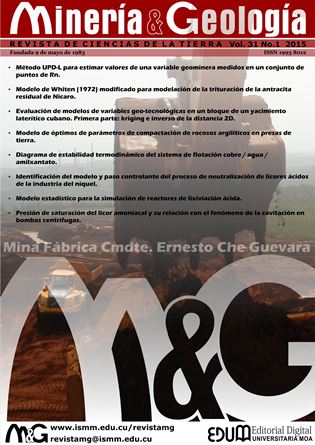Ammoniacal liquor saturation pressure and its relation with cavitation in centrifugal pumps
Keywords:
steam pressure, ammonia, cavitation, centrifugal pumps, three-phase fluids.Abstract
The experiment was carried out using water and ammonia liquor in order to obtain numerical values of the steam pressure and establish a connection between the pressure drop and bubble formation associated with cavitation in the centrifugal pumps operated for the transfer of ammoniacal liquor containing dissolved and suspended solids. The experiment was developed in two stages in which the saturation pressure of the ammoniacal liquor and the pressure drop were obtained when cavitation was induced to occur in a centrifugal pump. It was concluded that the pressure when bubbles are formed during the transfer of ammoniacal liquor at a concentration of 27 % and a saturation temperature of 22,15 ºC is 45,6·103 Pa. This is the minimum pressure threshold for the cavitation to occur in the centrifugal pump with the ammoniacal liquor set at 75% of volume flow.Downloads
References
BRENNE, C. E. 2011: Hidrodynamics of Pumps. Cambridge University Press. California Institute of Technology.
CISNERO, H. B. 2007: Cavitación, un ataque al corazón de las Bombas Centrífugas. [en línea] Consultado: 28 marzo 2007. Disponible en: http://www.mch.cl/documentos/pdf/cavita.pdf.
CONDE, M. 2004: Thermophysical Properties of NH3 + H2O Solutions for the Industrial Design of Absorption Refrigeration Equipment. Revista ENGINEERING. 1-34 p.
DOEBELIN, E. 1980: Diseño y aplicación de sistema de medición. Diana, México. GONZÁLEZ, V. 1983: Hidráulica, bombas y compresores. Pueblo y Educación, La Habana.
RODRÍGUEZ, J. F. 2010: Diseño de un ciclo de amoníaco agua en la estación de compresión de Tivissa. Enrique Querol Aragón (Tutor). Tesis de grado. Escuela Técnica Superior de Ingenieros de Minas. 77 p.
TURRO, A. 2002: Estudio del hidrotransporte de las colas en el proceso carbonato amoniacal. Leonel Garcell Puyans, Arístides Legrá Lobaina, Raúl Izquierdo Pupo (Tutores) Tesis doctoral. Instituto Superior Minero Metalúrgico de Moa. 100 p.
PÉREZ, R. 2004: Cavitación y materiales de construcción en las bombas centrífugas. Minería y Geología 20(3-4): 114-118.
RAMÓN, P. A. 1989: Transductores y acondicionamiento de señal. Marcombo.
RAMOS, N. 1994: Bombas, ventiladores y compresores. Editora ISPJAE, La Habana.
ROMERO, G. M. 2006: Análisis termodinámico de ciclo de refrigeración por absorción amoníaco-agua. Raúl Lugo Leiter (Asesor). Tesis de maestría. Instituto Politécnico Nacional. México D.F. 108 p
ROJAS, L. D. 2004: Identificación difusa de accionamiento de bombas centrifugas para el transporte eficiente de pulpa laterítica. Minería y Geología 20(3-4): 87-98.
REYES, J. L. 2010: Un experimento de enseñanza e investigación de la cavitación en bombas centrífugas. Asociación Americana de Profesores de Física 4(1): 2-18.
RINCÓN, E. A. & FRANCISCO, O. A. 2002: A New Troughlike Nonimaging Solar Concentrator. Energy engineering Journal 124(1): 51-55.
VILLAMIL, P. 2011: Proceso de transferencia de calor en un concentrador solar. Gerardo Ruiz Chavarría (Tutor). Tesis de grado. Universidad Nacional Autónoma de México. 74 p.
Published
How to Cite
Issue
Section
- Authors retain copyright and guaranteeing the right magazine to be the first publication of the work as licensed under a Creative Commons Attribution-NonCommercial that allows others to share the work with an acknowledgment of the work's authorship and initial publication in this journal.
- Authors may establish separate supplemental agreements for the exclusive distribution version of the work published in the journal (eg, place it in an institutional repository or publish it in a book), with an acknowledgment of its initial publication in this journal.
- Authors are allowed and recommended to disseminate their work through the Internet (e.g., in institutional telematic archives or on their websites) before and during the submission process, which can produce interesting exchanges and increase citations of the published work. (See The effect of open access)




